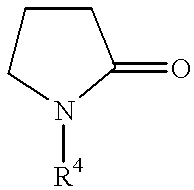Reduced residue hard surface cleaner
a hard surface cleaner and reducing residue technology, applied in the field of aqueous hard surface cleaners, can solve the problems of difficult cleaning of hard, glossy surfaces such as glass windows, poor soil removal ability of ammonia-based cleaners, and large residue left by cleaners on such hard, glossy surfaces, etc., to achieve excellent streaking/filming performance, enhance or maintain the effective minimization of streaking/filming on the cleaned surfaces, and effectively deliver
- Summary
- Abstract
- Description
- Claims
- Application Information
AI Technical Summary
Benefits of technology
Problems solved by technology
Method used
Image
Examples
example 1
[0061] In Table I below, base formulation "A" is set forth. Generally, the below examples of the compositions of this invention, as well as most of the comparative examples, will be based on the base formulation "A." Unless otherwise stated, percentages are given as 100% active, and in percent by weight.
1 TABLE I Ingredient Formulation A iso-Propyl Alcohol 4.0% Ethyleneglycol Monobutyl Ether 2.50% Primary Alkane Sulfonate 0.05% Diphenyl Oxide Disulfonate 0.05% Sodium Lauryl Sulfate 0.02% Dodecyl Pyrrolidone 0.012% Ammonium Carbamate 0.18% Fragrance 0.08% Ammonia 0.04998% Blue Dye(s) 0.0030% Deionized Water remainder to 100%
[0062] In general, to test the streaking / filming performance of the formulations, a small sample thereof was sprayed on glass mirror tiles and then wiped off. The results were graded by a panel of expert graders, on a scale of 0 to 10, with 0 being the worst and 10, the best.
[0063] In Examples 2-6 below, to further demonstrate the uniqueness and exemplary performa...
PUM
| Property | Measurement | Unit |
|---|---|---|
| vapor pressure | aaaaa | aaaaa |
| Vapor pressure | aaaaa | aaaaa |
| pH | aaaaa | aaaaa |
Abstract
Description
Claims
Application Information
 Login to View More
Login to View More - R&D
- Intellectual Property
- Life Sciences
- Materials
- Tech Scout
- Unparalleled Data Quality
- Higher Quality Content
- 60% Fewer Hallucinations
Browse by: Latest US Patents, China's latest patents, Technical Efficacy Thesaurus, Application Domain, Technology Topic, Popular Technical Reports.
© 2025 PatSnap. All rights reserved.Legal|Privacy policy|Modern Slavery Act Transparency Statement|Sitemap|About US| Contact US: help@patsnap.com

